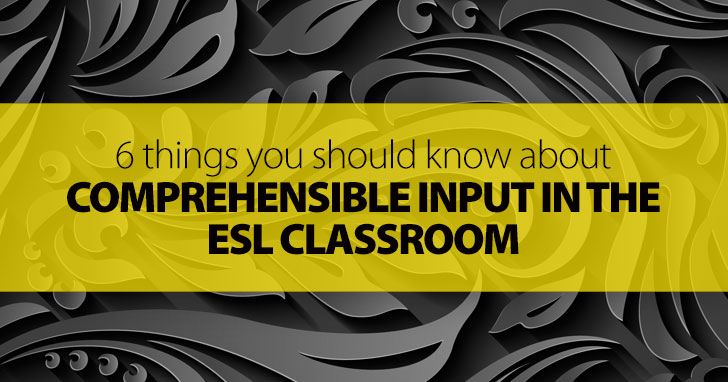More Than a Syllabus Robot: 6 Things You Can Do Today to Make Class More Meaningful for Your Students


In the process of making ourselves better, however, we can sometimes get bogged down in the technical vocabulary and lose sight of our goals. One such term is comprehensible input. We all need it and need how to use it, but what exactly does the term mean? Here’s everything you need to know about what comprehensible input is and how to make sure you are including it in your ESL class.

No matter what your students’ level is, you can point to a rough measure of what they understand. For absolute beginners, it might be a set of five commonly used phrases and a handful of vocabulary. For high advanced students, it might be close to what native speakers understand. Whatever the quantity of information that they understand, you can call it i. i is a general variable representing the specific level of language a certain student or class understands. Every student and class might have a different level of skill, but when you are talking about each one, you can call that class’ skill level i. It’s kind of like solving for x in algebra equations. X represents a different number in each equation, but you always use the term x to represent the unknown. So your students understand a certain amount of language, and we call that i. In order to understand what comprehensible input is, you have to know what the i of your class is.
One key aspect to comprehensible input in your ESL classroom is that it is just above what your students already understand, that is to say it’s a little more than i. That’s where the expression i+1 comes from. You don’t want your input or information to be too far above where your students are currently, what they already understand. You might represent material far above their current level as i+2 or i+3. When your input is too far above where your students are at the moment, it becomes overwhelming for them, too difficult to understand, and in the worst case scenario useless because it causes your students to completely shut down. Your ideal materials (i+1) should be a blend of what your students understand now and new words, grammar structures, and general English that they don’t understand yet. You can think of it like chocolate chip ice-cream. The vanilla ice-cream is what they already understand. The chips are the bits of language beyond what they already know. They are throughout the mixture and do not overwhelm it. They are just enough to make it interesting and appealing. They make it special just as the unfamiliar bits of language make what your students are reading or listening to more interesting rather than overwhelming. It’s a challenge for your students, but not too much of one.
Not all comprehensible input will come from your ESL textbooks. By definition it’s any language your students have to digest. Sometimes it comes in audio form. This can be you speaking, a video from YouTube or movie clip, a recorded conversation, an automated phone menu, etc. Written input might come from the text book, the newspaper, a website, a menu, a map, etc. You are only as limited as your imagination. If you find materials created for the use of native speakers, even better. The best sources of input are those that your students will encounter once they are out of the classroom, real life materials. Just make sure it’s at the correct level to challenge your students without overwhelming them. (There’s that i+1 again.)
Once you figure out what your students know and what i+1 is for them, you still have to think about a couple of things before you have truly comprehensible input. Not every piece of writing or audio clip of speaking is appropriate or interesting for your students. If a story or an essay has no relation to what you are teaching, it is not a good choice for your students even if it is i+1. So when you choose appropriate materials for your class, think about what topics you are covering in class, what grammar structures you are trying to teach, what vocabulary you want your students to learn, and what material that is i+1 relates those things. If it’s quality, i+1, and ties into what you are teaching your students, you have comprehensible input.
Part of the goal of comprehensible input is to challenge your students. If they can understand everything they hear or read, it’s not a challenge. So once you choose your materials, it’s your job to help your students understand them. Remember they are a little above what your students understand on their own. You have hundreds of options when it comes to helping your students understand the material you give them. You might preteach vocabulary and grammatical structures to help them digest what they hear and read. You might use graphic organizers to help them process and organize the information as they receive it. You might give them questions and answers about the material or structures that they can use to decipher the meaning of the new input on their own. Encourage your students to ask questions when they need clarification. Change up your methods, and make sure your students are engaged with the material even the pieces that they don’t yet understand. The better you know your class and the more teaching techniques you have under your belt, the easier this will be to achieve.
When it comes down to it, your top goal as an ESL teacher is getting your students to use the English language. Of course you want them to use it correctly and to feel comfortable with it. Ultimately, though, you want more than just head knowledge; you want fluency that comes from English finding its place in their hearts. If the material you are using in class enables your students to use English in effective ways, if it enables them to communicate their ideas and opinions and understand those of others, your material is effective.